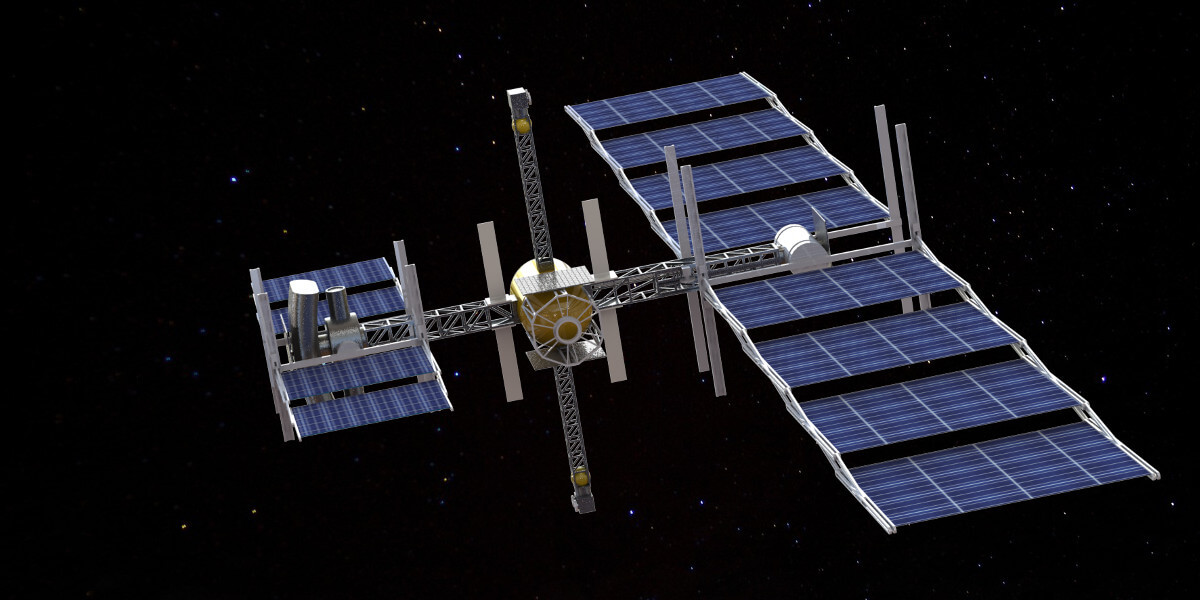
The team’s spaceship concept “Hyperion.” Image/Jacob Inouye
After a nine-month long effort designing a Mars transport vehicle for NASA’s space travel competition, a team of USC Viterbi School of Engineering students won first place in the graduate division.
The yearly competition, Revolutionary Aerospace Systems Concepts – Academic Linkage (RASC-AL), culminated in a three-day long forum where the finalists from dozens of university teams competed together in Cocoa Beach, Fla. on June 18-21. This was the first USC team to make it through the initial two competition rounds to make it to the finals, and the first graduate team ever.
During the competition, university-level students work together to design and analyze spacecraft and architectures that will enable long-distance space travel. This year, students had a choice of four themes of space exploration. The Viterbi team, consisting of Gedi Minster, Alexander Chang, Jacob Inouye, Sriram Narayanan, Austin Carter, and Jialing Tong, chose the theme titled “Artificial Gravity Reusable Crewed Deep Space Transport.” Their mission: to design a spaceship with an artificial gravity similar to Mars that can last for three missions to and from Earth over a span of 15 years.

The team at the RASC-AL competition in Cocoa Beach, Fla. Left to right: Jialing Tong, Gedi Minster, Sriram Narayanan, David Barnhart, Alexander Chang and Jacob Inouye. Photo/ NASA/RASC-AL
While the reason to simulate the gravity of Mars was unspecified, Minster – the team’s leader – postulates that its purpose is to get astronauts acclimated to the conditions on Mars prior to stepping on the red planet.
“The concern is that astronauts, after spending six months in interplanetary space, are going to land on Mars and they won’t be able to function effectively,” said Minster. “That’s why we are creating artificial gravity – to get them ready during their long journey.”
After living in the zero-gravity environment aboard the International Space Station, when astronauts return to Earth it’s difficult for them to move around. In addition to Earth’s gravity, they have to readjust their sense of orientation and balance. It can take weeks before they are able to function normally – time that would be wasted by new explorers on Mars.
To simulate gravity, the team, advised by Research Professor David Barnhart, director of the Space Engineering Research Center at USC’s Information Sciences Institute, designed a spaceship that spins. The rotation creates a pulling sensation towards the floor of the spacecraft that mimics the effects of gravity. In this case, the team calculated that their spacecraft would need to spin at the rate of about three rotations per minute to simulate the gravity of Mars, which is roughly 38 percent that of Earth’s.
This method of creating artificial gravity is widely used in sci-fi movies and is currently the most technologically feasible option. “But exactly what you spin is one of the big design choices,” Minster explained. The Viterbi team was the only one in the competition to choose to spin their entire spaceship. This let them avoid dealing with the tricky connectivity issues between rotating and stationary modules.
Their novel design included several features to accommodate the unique rotation. To maintain balance, they used a dynamic structure that retracts or extends to account for mass changes as fuel and resources are consumed. To maintain communications with Earth, they utilized proven antenna technology currently employed on NASA’s MarCO spacecraft that moves electronically rather than mechanically and is able to orient the direction in milliseconds.
Finally, once the spaceship reaches its destination, they will convert the solar panels into “parachutes” to increase drag and gradually slow the vehicle without using expensive propulsion systems, a method called “aerobraking” that is used by the European Space Agency and Russia’s Roscosmos ExoMars orbiter.
To ensure the success of their project, the engineers, consisting of both graduate and undergraduate students from the Department of Astronautical Engineering and the Department of Aerospace and Mechanical Engineering, worked with reviewers from NASA’s Jet Propulsion Laboratory and scientists from ESA’s ExoMars team. They also collaborated with students from the USC School of Architecture to design their poster and the USC School of Cinematic Arts to create the following video directed and edited by Jono Seneff.
They plan on presenting their work at the International Astronautical Conference in Germany this October.
Published on July 6th, 2018
Last updated on June 3rd, 2021













